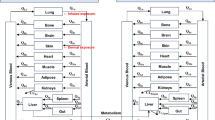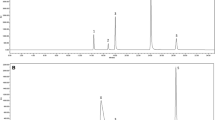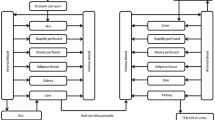Abstract
The aim of this study was to determine the percutaneous absorption flux of BaP (20 μg/cm2 in ethanol) and the usefulness of urinary 3-OHBaP as a bio-indicator of dermal exposure to BaP. The percutaneous absorbed dose and absorption flux were estimated by comparison with intravenous administration of BaP (0.01 and 0.05 mg/kg in Cremophor®) as reference way. A percutaneous absorption flux of 0.37 μg/cm²/h was determined by killing groups of rats, following exposure time of 4.5 and 24 h. [14C] skin content was 3.1 μg/cm2, after 24 h exposure to BaP. Total urinary 3-OHBaP accounted for 0.4% of the real absorbed dose, which was fourfold higher than the percentage of an intravenous dose excreted as 3-OHBaP. This finding reveals that percutaneous absorption of BaP, based on the ratio of urinary excretion of 3-OHBaP following percutaneous exposure compared to percutaneous absorption following intravenous administration of BaP, is overestimated in the rat. In vitro, BaP was intensively metabolised by rat skin. Unchanged BaP and 3-OHBaP in receptor fluid accounted for 50 and 30% of the total radioactivity. This percutaneous first past effect of BaP in rats could, in part, explain the higher urinary excretion ratio of 3-OHBaP compared to the value based on intravenous administration of BaP. Conversely, BaP was largely lower metabolised as 3-OHBaP during percutaneous absorption by humans, so BaP absorption flux should be overestimated to a lesser extent in humans than in rats.




Similar content being viewed by others
Abbreviations
- BaP:
-
Benzo(a)pyrene
- 3-OHBaP:
-
3-Hydroxybenzo(a)pyrene
- BSA:
-
Bovine serum albumin
- PAH:
-
Polycyclic aromatic hydrocarbons
- i.v.:
-
Intravenous
- HPLC:
-
High performance liquid chromatography
References
Angerer J, Mannschreck C, Gundel J (1997) Occupational exposure to polycyclic aromatic hydrocarbons in a graphite-electrode producing plant: biological monitoring of 1-hydroxypyrene and monohydroxylated metabolites of phenanthrene. Int Arch Occup Environ Health 69:323–331
Ariese F, Verkaik M, Hoornweg GP, van de Nesse RJ, Jukema-Leenstra SR, Hofstraat JW, Gooijer C, Velthorst NH (1994) Trace analysis of 3-hydroxy benzo[a]pyrene in urine for the biomonitoring of human exposure to polycyclic aromatic hydrocarbons. J Anal Toxicol 18:195–204
Becker K, Schulz C, Kaus S, Seivert B (2003) German Environmental Survey 1998 (GerEs III): environmental pollutants in urineof the German population. Int J Hyg Environ Health 206:15–24
Bentsen-Farmen RK, Botnen IV, Noto H, Jacob J, Ovrebo S (1999) Detection of polycyclic aromatic hydrocarbon metabolites by high-pressure liquid chromatography after purification on immunoaffinity columns in urine from occupationally exposed workers. Int Arch Occup Environ Health 72:161–168
Boogaard PJ, van Sittert NJ (1994) Exposure to polycyclic aromatic hydrocarbons in petrochemical industries by measurement of urinary 1-hydroxypyrene. Occup Environ Med 51:250–258
Bouchard M, Viau C (1996) Urinary excretion kinetics of pyrene and benzo(a)pyrene metabolites following intravenous administration of the parent compounds or the metabolites. Toxicol Appl Pharmacol 139:301–309
Brzeznicki S, Jakubowski M, Czerski B (1997) Elimination of 1-hydroxypyrene after human volunteer exposure to polycyclic aromatic hydrocarbons. Int Arch Occup Environ Health 70:257–260
Buckley TJ, Lioy PJ (1992) An examination of the time course from human dietary exposure to polycyclic aromatic hydrocarbons to urinary elimination of 1-hydroxypyrene. Br J Ind Med 49:113–124
Clonfero E, Zordan M, Venier P, Paleologo M, Levis AG, Cottica D, Pozzoli L, Jongeneelen FJ, Bos RP, Anzion RB (1989) Biological monitoring of human exposure to coal tar. Urinary excretion of total polycyclic aromatic hydrocarbons, 1-hydroxypyrene and mutagens in psoriatic patients. Int Arch Occup Environ Health 61:363–368
Fan R, Dong Y, Zhang W, Wang Y, Yu Z, Sheng G, Fu J (2006) Fast simultaneous determination of urinary 1-hydroxypyrene and 3-hydroxybenzo[a]pyrene by liquid chromatography-tandem mass spectrometry. J Chromatogr B Analyt Technol Biomed Life Sci 836:92–97
Forster K, Preuss R, Rossbach B, Bruning T, Angerer J, Simon P (2008) 3-Hydroxybenzo[a]pyrene in the urine of workers with occupational exposure to polycyclic aromatic hydrocarbons in different industries. Occup Environ Med 65:224–229
Gendre C, Lafontaine M, Morele Y, Payan JP, Simon P (2002) Relationship between urinary levels of 1-hydroxypyrene and 3-hydroxypyrene for workers exposed to polyclyc aromatic hydrocarbons. Polycycl Aromat Compd 22:761–769
Gendre C, Lafontaine M, Delsaut P et al (2004) Exposure to polycyclic aromatic hydrocarbons and excretion of urinary 3-hydroxybenzo[a]pyrene: assessment of an appropriate sampling time. Polycycl Aromat Compd 24:433–439
Gundel J, Angerer J (2000) High-performance liquid chromatographic method with fluorescence detection for the determination of 3-hydroxybenzo[a]pyrene and 3-hydroxybenz[a]anthracene in the urine of polycyclic aromatic hydrocarbon-exposed workers. J Chromatogr B Biomed Sci Appl 738:47–55
Gundel J, Schaller KH, Angerer J (2000) Occupational exposure to polycyclic aromatic hydrocarbons in a fireproof stone producing plant: biological monitoring of 1-hydroxypyrene, 1-, 2-, 3- and 4-hydroxyphenanthrene, 3-hydroxybenz(a)anthracene and 3-hydroxybenzo(a)pyrene. Int Arch Occup Environ Health 73:270–274
Heudorf U, Angerer J (2001a) Internal exposure to PAHs of children and adults living in homes with parquet flooring containing high levels of PAHs in the parquet glue. Int Arch Occup Environ Health 74:91–101
Heudorf U, Angerer J (2001b) Urinary monohydroxylated phenanthrenes and hydroxypyrene—the effects of smoking habits and changes induced by smoking on monooxygenase-mediated metabolism. Int Arch Occup Environ Health 74:177–183
IARC (International Agency for Research on Cancer) (1983) Benzo[a]pyrenr. In: IARC monographs on the evaluation of carcinogenic risk of chemicals to humans. Polycyclic aromatic compounds, part 1, chemical, environmental and experimental data, vol 32. Lyon
Jongeneelen FJ, Anzion RB, Scheepers PT, Bos RP, Henderson PT, Nijenhuis EH, Veenstra SJ, Brouns RM, Winkes A (1988a) 1-Hydroxypyrene in urine as a biological indicator of exposure to polycyclic aromatic hydrocarbons in several work environments. Ann Occup Hyg 32:35–43
Jongeneelen FJ, Scheepers PT, Groenendijk A, Van Aerts LA, Anzion RB, Bos RP, Veenstra SJ (1988b) Airborne concentrations, skin contamination, and urinary metabolite excretion of polycyclic aromatic hydrocarbons among paving workers exposed to coal tar derived road tars. Am Ind Hyg Assoc J 49:600–607
Kao J, Patterson FK, Hall J (1985) Skin penetration and metabolism of topically applied chemicals in six mammalian species, including man: an in vitro study with benzo[a]pyrene and testosterone. Toxicol Appl Pharmacol 81:502–516
Lafontaine M, Payan JP, Delsaut P, Morele Y (2000) Polycyclic aromatic hydrocarbon exposure in an artificial shooting target factory: assessment of 1-hydroxypyrene urinary excretion as a biological indicator of exposure. Ann Occup Hyg 44:89–100
Lafontaine M, Gendre C, Morele Y, Laffitte-Rigaud G (2002) Excretion of urinary 1-hydroxypyrene in relation to the penetration routes of polycyclic aromatic hydrocarbons. Polycycl Aromat Compd 22:579–588
Lafontaine M, Gendre C, Delsaut P et al (2004) Urinary 3-hydroxybenzo[a]pyrene as a biomarker of exposure to polycyclic aromatic hydrocarbons: an approach for determining a biological limit value. Polycycl Aromat Compd 24:441–450
Moody RP, Nadeau B, Chu I (1995) In vivo and in vitro dermal absorption of benzo[a]pyrene in rat, guinea pig, human and tissue-cultured skin. J Dermatol Sci 9:48–58
Ng KM, Chu I, Bronaugh RL, Franklin CA, Somers DA (1992) Percutaneous absorption and metabolism of pyrene, benzo[a]pyrene, and di (2-ethylhexyl) phthalate: comparison of in vitro and in vivo results in the hairless guinea pig. Toxicol Appl Pharmacol 115:216–223
Payan JP, Lafontaine M, Simon P, Marquet F, Gendre C, Beydon D, Ferrari E (2008) In vivo and in vitro percutaneous absorption of [(14)C]pyrene in Sprague Dawley male rats: skin reservoir effect and consequence on urinary 1-OH pyrene excretion. Arch Toxicol 82:739–747
Quinlan R, Kowalczyk G, Gardiner K, Calvert IA, Hale K, Walton ST (1995) Polycyclic aromatic hydrocarbon exposure in coal liquefaction workers: the value of urinary 1-hydroxypyrene excretion in the development of occupational hygiene control strategies. Ann Occup Hyg 39:329–346
Ritschel WA (1980) Handbook of basic Pharmacokinetics. Hamilton, IL
Simon P, Lafontaine M, Delsaut P, Morele Y, Nicot T (2000) Trace determination of urinary 3-hydroxybenzo[a]pyrene by automated column-switching high-performance liquid chromatography. J Chromatogr B Biomed Sci Appl 748:337–348
Van Rooij JG, Bodelier-Bade MM, De Looff AJ, Dijkmans AP, Jongeneelen FJ (1992) Dermal exposure to polycyclic aromatic hydrocarbons among primary aluminium workers. Med Lav 83:519–529
Van Rooij JG, Bodelier-Bade MM, Jongeneelen FJ (1993) Estimation of individual dermal and respiratory uptake of polycyclic aromatic hydrocarbons in 12 coke oven workers. Br J Ind Med 50:623–632
Acknowledgments
We would like to thank P. Maxant and P. Sibille for their help in conducting this study and M. C. Grandclaude for her technical assistance. This study was part of the “Evaluation and prediction of dermal absorption of toxic chemicals” project (QLRT-2000-00196), supported by the 5th Framework Program of the European Commission.
Author information
Authors and Affiliations
Corresponding author
Rights and permissions
About this article
Cite this article
Payan, JP., Lafontaine, M., Simon, P. et al. 3-Hydroxybenzo(a)pyrene as a biomarker of dermal exposure to benzo(a)pyrene. Arch Toxicol 83, 873–883 (2009). https://doi.org/10.1007/s00204-009-0440-0
Received:
Accepted:
Published:
Issue Date:
DOI: https://doi.org/10.1007/s00204-009-0440-0




